October 28, 2010
By Judd Cooney
Mossey-Horned Old Whitetails Seldom Play By The Rules.
By Judd Cooney
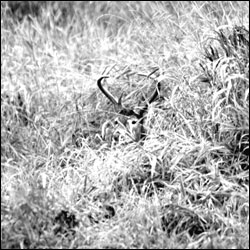 It doesn't take much cover to satisfy a wary buck's needs as long as he is in position to see, hear or smell any approaching danger. However, once you jump him out of his favorite "hideyhole," he is liable to travel a mile or more to find another secluded location. If you've located a key "hideyhole," you may only get one chance at the buck using it. Planning, patience and finesse are the keys to winning the encounter. |
I hate it when a decent buck appears broadside at point blank range the first day of the fall bowhunting adventure. I always seem to make the wrong decision. If I take the buck and end my hunt before it gets a good start, you can bet I'll have a "boomer" buck appear shortly thereafter, and I'll be cussing my impatience. If I pass on the buck and wait for Mr. Big, either he won't show or he'll aggravate the situation by appearing and disappearing without ever giving me a shot.
That was the situation I faced last fall on the very first day I bowhunted a dense, almost impenetrable hideyhole on the Indian reservation along the Missouri River. I'd bowhunted this tight little chunk of deer domain for the past couple years and had a pretty good handle on deer movement and travel patterns. It was impossible to move a hundred yards through the jungle-like cover without jumping a deer.
Advertisement
I had previously hung two tree stands overlooking trail junctions on both ends of the thicket so I could bowhunt the area regardless of wind direction. The first morning I sneaked quietly into the downwind stand where the breeze was in my favor. I'd been in the stand for half an hour, when two does and a small fork buck drifted out of the grayness, milled around under my stand inhaling the pungent smoke from my scent sticks, and then disappeared into the engulfing brush.
I waited impatiently for another 20 minutes and then grunted softly on my new grunt call. A minute later I caught movement in the thick brush and with the aid of my binoculars I picked out the almost indistinguishable shape of a deer less than 40 yards away. After a few fruitless, eye-watering minutes trying to discern antlers in the tangle of branches, I inhaled another soft grunt on the call tube pinned to my collar. That did the trick.
Advertisement
The dark, heavy-antlered, nine-point buck eased slowly to the edge of the small clearing within 15 yards of my stand, and stopped.
The buck's attention was locked on the white column of smoke scent drifting upward from the sticks. I had my bow in easy drawing position, but couldn't convince myself to take the shot. The buck would have scored in the high 130s, but man it was only my first day of hunting. Dang! I was still doing mental gymnastics, when the buck remedied the situation by melting back into the brush from whence he came.
I have a passion for locating buck hideyholes and then trying to figure out how to get myself, or a client, into position for a shot at a mature buck. This endeavor can lead to frustrations of the highest degree. Buck hideyholes are generally those little weed lots, timber patches or sloughs that don't get a second look from wise and worldly deer hunters, but seem to fit a wily whitetail's needs perfectly.
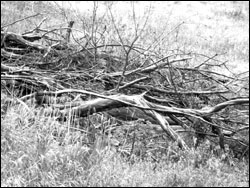 Locate a small area that you feel is the least likely place for a buck to hide and carefully check it out, because that may be just the spot a wary old buck will choose. In areas where deer live in close proximity to people, they'll often pick a spot so obvious that even the most discerning bowhunter wouldn't think of looking there. In South Dakota, the author accidentally jumped a 150-class buck from the buck's "hideyhole" under a bridge Cooney drove across several times a day while scouting for deer. |
A pressured buck is going to find a place where he is undisturbed and stay there until he gets bumped; then he'll find another such spot. After surviving a few seasons, a mature buck has a number of hideyholes in the vicinity of his home range, and you can bet they're places hunters rarely think of looking. Such a buck sanctuary only has to be large enough to provide the buck with enough escape cover to stay hidden during the daylight hours and are often much smaller than a hunter would think a big buck would prefer.
Several years ago, an Iowa farmer told me about a huge 12-point buck he'd seen on his farm numerous times shortly after the firearms season started.
The buck would sneak across his open pasture and feedlot in the early morning and bed down in an old, unused hog lot overgrown with head-high weeds. The lot was about 50 yards square and within 100 yards of the landowner's barn. He never saw the buck leave the patch before full dark.
The farmer had several acquaintances stop and ask permission to hunt his creek bottoms several miles from the farmhouse, but he never spoke of the big buck. He told me that if they couldn't scout enough to find the buck's hideyhole, he wasn't going to tell them. You can bet I check the roadway for tracks every time I go past there during the season, but so far the buck has never returned.
Last fall I bowhunted with Mark Bauer and Dan Koepp of Ambush Acres Outfitters, near Freeman, South Dakota, and came across another buck hideyhole just begging for a serious hunter. Mark and Dan have so much good deer-hunting country that they have not taken the time to make use of this super spot.
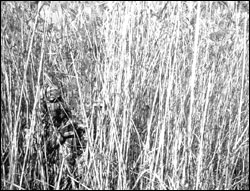 Getting a shot at a buck bedded in weeds this thick is almost impossible. Try to set up your ambush on the main trail entering or leaving the area rather than take a chance on blowing him out of his sanctuary. This tactic could require nighttime scouting because a really cagey buck may enter and leave an isolated weed patch only during the hours of darkness. Nobody said bowhunting "hideyhole" bucks was easy, or a sure thing. |
There is an isolated waterhole dugout right in the middle of one of their leased sections that is surrounded by corn and soybean fields. The small, but deep water-filled dugout is in the center of a 100- by 50-yard slough overgrown with waist-high marsh grass and dense willows. There aren't any trees in the slough, but the two weed- and willow-covered dirt berms flanking the waterhole would make an ideal location for a pair of pit blinds to cover all approaches.
When Mark, Dan and I scouted the dugout th
ere was plenty of deer sign and beds, indicating the deer had been moving from the surrounding corn fields to water and bed around the waterhole early in the season. Later in the season, when the deer in the area get pressured, they leave the surrounding creek bottoms, CRP fields and shelter belts and several good bucks and a number of does generally end up utilizing the dugout slough. From this unique hideyhole the deer can see any approaching hunters and are quick to bolt across the open prairies.
Extreme finesse and patience is the key to successfully bowhunting such a location. Early in the season when crops are still in the field, it would be relatively easy with the wind in your favor to sneak carefully to the dugout in the predawn darkness and set up for a morning hunt to catch the deer coming in for water; the hotter the weather the better your chances of arrowing a good buck. This hideyhole would be excellent for an all-day hunt because the deer would be accustomed to moving in and out of the tank to water, without having to venture into the open.
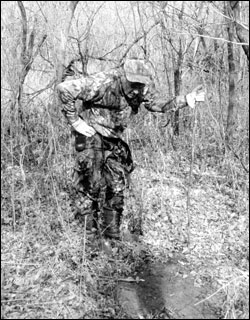 The author examines a fresh scrape in a thicket along the Missouri River where bucks like to bed during the day. Many bowhunters believe you can judge the size of a buck by the size of a tree he rubs. Not necessarily so when a big buck lives in a swamp or thicket with small trees. If that's what is available it is not likely he'll go out of his way to find a big tree to rub. Fresh tracks around rubs or scrapes will give the hunter a better handle on the buck's size. |
I'd planned on giving this hideyhole a go this past fall when I bowhunted the area, especially during the opening of rifle season when I knew from the previous year's observations deer would definitely be moving to the protective cover around the dugout during the first days of the season. South Dakota allowed bowhunting during the gun season, but I never got a chance to hunt the spot because I arrowed a good buck the second day of an earlier bowhunt, ending all thoughts of bowhunting the hideyhole.
Big, mature bucks have a propensity for seeking out small isolated sanctuaries when hunters invade their normal home range. Each fall in Iowa, I get several reports of bird hunters jumping monster bucks out of small, secluded pockets of cover when they are hunting pheasants and quail. Whenever possible, I try to check out such spots for possible future use. Often these unique little oasis' aren't that important to the landowner and it's easy to get permission to bowhunt them.
Many wise and wary old bucks become seemingly impossible to kill by disappearing into an undiscovered hideyhole during season and venturing forth only after full dark and returning before daylight. Even during the rut, when bucks are supposedly sex crazed and stupid, these hideyhole bucks will sneak out at night, round up a doe and keep her hidden with them in their nook until she's bred, never exposing themselves during daylight hours.
On an early morning several years ago, I spotted a 170-class buck at the edge of a 50- by 100-yard patch of timber in a draw smack in the center of a section of open pasture where I least expected to see a deer, let alone a buck of that caliber. This occurred during the second shotgun season. I got landowner permission and sneaked four gun hunters around the patch, and they still blew the setup and let the Boone-and-Crockett buck escape. I've checked that pocket a dozen times since and never found enough deer sign to warrant bowhunting it.
Ron Wadsworth, an Illinois bowhunter who is also an outfitter, ran into a monstrous hideyhole buck a few years back that tested his skills and luck to the limit. The previous fall, one of Ron's bowhunting clients had hit a monstrous buck in the antler, and shortly after season Ron spotted the buck feeding in a cornfield on his property. That spring Ron found one of the buck's sheds complete with broadhead-chipped main beam.
Ron had an idea where the elusive buck was bedding and in September he was scouting, trying to pinpoint the buck's hideyhole when he jumped the humongous buck from a small weed-grown field situated between two deep draws that led to timber.
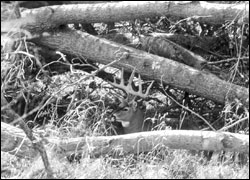 Take your time to thoroughly scout a buck "hideyhole" and locate all his travel and escape routes. A buck doesn't pick his secluded nest to make it easy for a hunter to find him and such a spot might be right next to a building, road or natural obstruction. The best way to hunt such a location is to unobtrusively pattern the buck's comings and goings and try to ambush him on the way in or out. If you blow the chance there may be an opportunity for another encounter from a different ambush point. |
He located a well-used bed eight feet in diameter in the waist-high weeds midway between the two gullies. The buck could observe traffic on the main road a half mile away and see anyone approaching from any direction except for a small grassy knoll to the north of his nest. He was only a couple jumps from escape routes on both sides, and completely hidden from view.
Ron went back to the area the following day and hung a tree stand in the timbered draw overlooking the most traveled escape route, and then stayed out of the area until the first of November. The first time he slipped in to bowhunt the buck he forgot he had taken three tree steps out of the tree, and couldn't make it up into the stand. He moved down the ridge to ponder the situation and a few minutes later the buck appeared in the timber and walked right under his stand. A few days later he got his chance at the monster buck and missed. He hunted the stand three more days and never saw a deer.
Ron gave up the stand until shotgun season arrived the following weekend, figuring that the minute his neighbor parked on the road and moved to his stand the deer would see him and move down the trail giving him another chance at the buck. On opening day he sat his stand all day long while staring at his neighbor, who sat on the other side of a fence only a few yards away. The neighbor was a persistent hunter and also aware of the big buck's presence.
As much as Ron wanted to take the big buck with his bow, he succumbed to the competition and took his shotgun to the stand the second day. Once again he and the neighbor stared silently at each other and the unoccupied woods all day. Finally, at 3:30 his competition climbed down and left the area. Ron quickly decided to sneak in on the hideyhole in hopes the buck was there. Ron sneaked to within 40 yards of the bed and spotted the antler tips sticking up out of the frost-killed weeds. Two well-placed shots later he had the hideyhole buck of a lifetime.
Mossy-horned, old bucks don't play by the rules. If you're going to be successful in adding one of these sneaky, unconventional, baffling bucks to your trophy room wall you'd best start scout
ing areas where you'd least expect to find such a buck, 'cause that's the secret of success for "hideyhole bucks."
